Tracy Hilton here from Food and Meal, excited to share with you one of my favorite rice dishes – the aromatic, flavorful Persian Rice!
As someone who loves exploring new cuisines in my home kitchen, I was so intrigued when my friend first told me about Persian rice. Also called chelo, it’s a beloved staple in Iranian cooking that transforms plain rice into something truly special. The technique of cooking the rice in oil or butter to create a crispy golden crust, called tahdig, sounded amazing. I couldn’t wait to try making my own version!
When I cooked my first batch of Persian rice, the exotic aromas of saffron and cardamom that filled my kitchen were so enticing. And biting into that crispy, buttery tahdig at the bottom was an incredible textural contrast. I was amazed that such flavorful, restaurant-quality rice could be made at home with some simple ingredients and a little technique.
Now whenever I’m planning a special meal, Persian rice is my go-to side dish. It feels elegant and sophisticated while still being approachable on a weeknight. I love experimenting with different oil and spice combinations to put my own spin on it, playing with ingredients like turmeric, cumin and parsley.
Persian Rice recipes
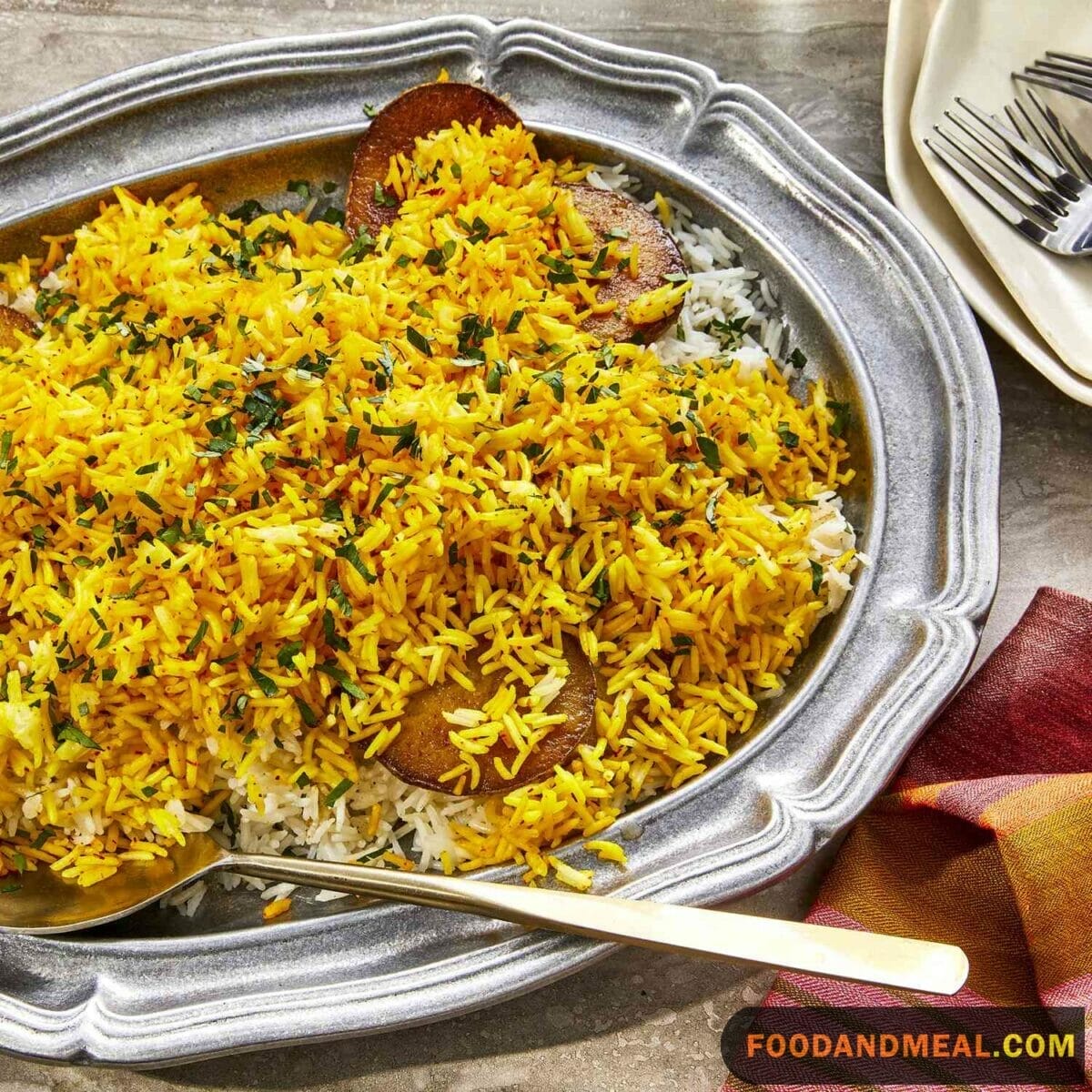
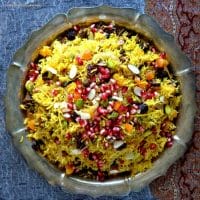
Persian Rice
Equipment
Ingredients
- 4 medium onions 1 1/2 lb/700 g before peeling
- 3 tablespoons all-purpose flour
- 1 sunflower oil or vegetable
- 2 teaspoons cumin seeds
- 1 1/2 tablespoons coriander seeds
- 2 cup basmati rice
- 2 tablespoons olive oil
- 1/2 teaspoon ground turmeric
- 3 cups water
- Salt and freshly ground black pepper
Instructions
- Peel the onions and slice thinly. Sprinkle with the flour and 1 teaspoon salt, and mix well with your hands.
- Heat the oil in a medium heavy-bottomed saucepan placed over high heat. Make sure the oil is hot by throwing in a small piece of onion; it should sizzle vigorously.
- Reduce the heat to medium-high and cautiously (oil will be very hot) add one-third of the sliced onion. Fry for 5 to 7 minutes, stirring occasionally with a slotted spoon, until the onion takes on a nice golden brown color and turns crispy (adjust the temperature if necessary to avoid burning the onion).
- Use the spoon to transfer the onion to a colander lined with paper towels and sprinkle with a little more salt. Repeat with the remaining 2 batches of onion. Add oil if necessary.
- Wipe the saucepan in which you fried the onion clean and put in the cumin and coriander seeds. Place over medium heat and toast the seeds for a minute or two.
- Add the rice, olive oil, turmeric, 1/2 teaspoon salt (or more to taste), and plenty of black pepper. Stir to coat the rice with the oil and then add the water. Bring to a boil, cover with a lid, and simmer over very low heat for 15 minutes.
- Remove from the heat, lift off the lid, and quickly cover the pan with a clean tea towel. Seal tightly with the lid and set aside for 10 minutes.
- Add half the fried onion to the rice and stir gently with a fork. Pile the mixture in a shallow serving bowl and top with the rest of the onion.
Video
Notes
Nutrition
© Food And Meal
This website provides approximate nutrition information for convenience and as a courtesy only. Nutrition data is gathered primarily from the Spoonacular Database, whenever available, or otherwise other online calculators.
Alternative Method: Oven-Baked Persian Rice
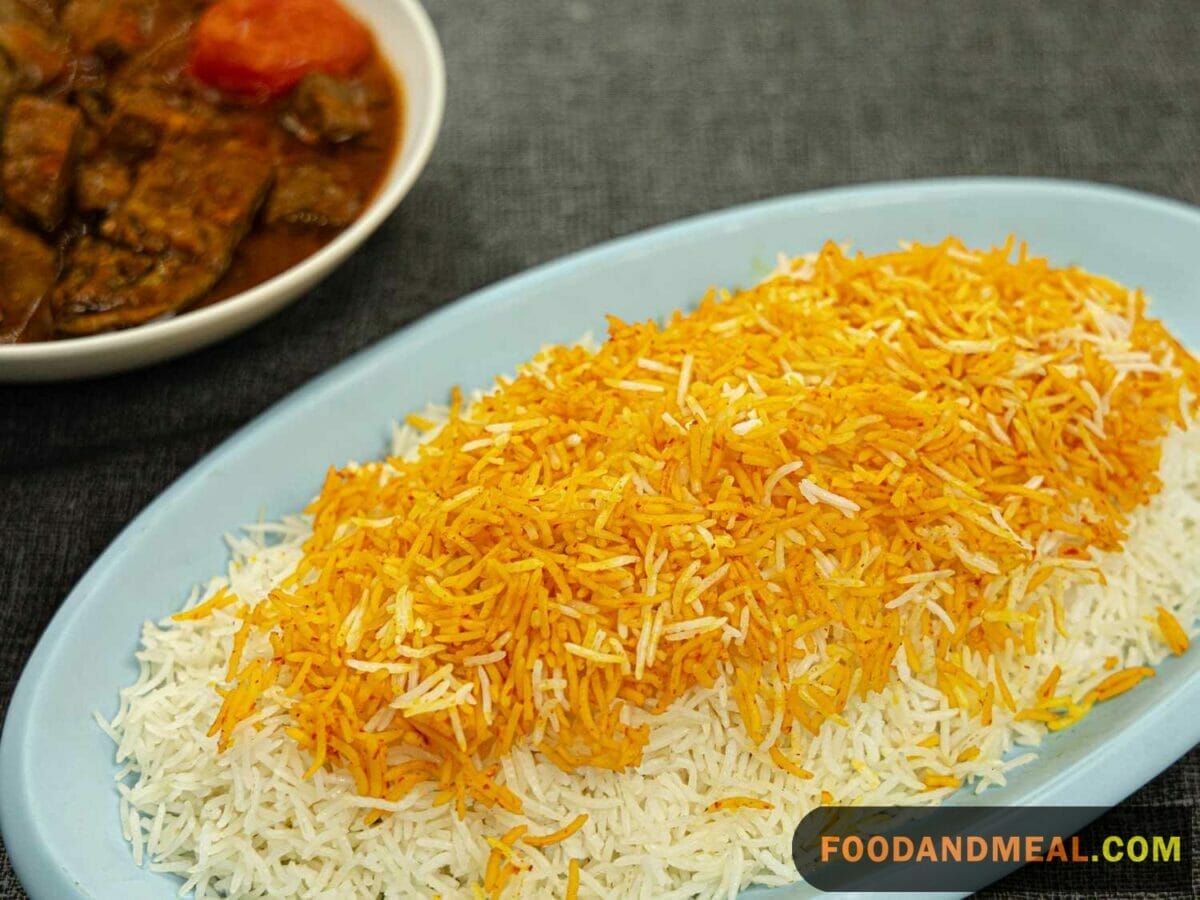
To complement the rich flavors of your oven-baked Persian rice, consider pairing it with a dish like Chicken Briyani. The fragrant spices and tender chicken of the biryani will harmonize beautifully with the aromatic saffron-infused rice, creating a tantalizing fusion of Persian and Indian cuisines. Alternatively, you could opt for a lighter accompaniment such as a Kale Caesar Salad, offering a refreshing contrast to the hearty rice dish. For those seeking a vegetarian option, pairing the Persian rice with Vegetable Maki would provide a delightful combination of textures and flavors, with the sushi rolls adding a touch of elegance to the meal. Whichever pairing you choose, be sure to savor the crispy Tahdig and fragrant aroma of this exquisite oven-baked Persian rice dish.
Tips for making Persian Rice
Cooking Tips
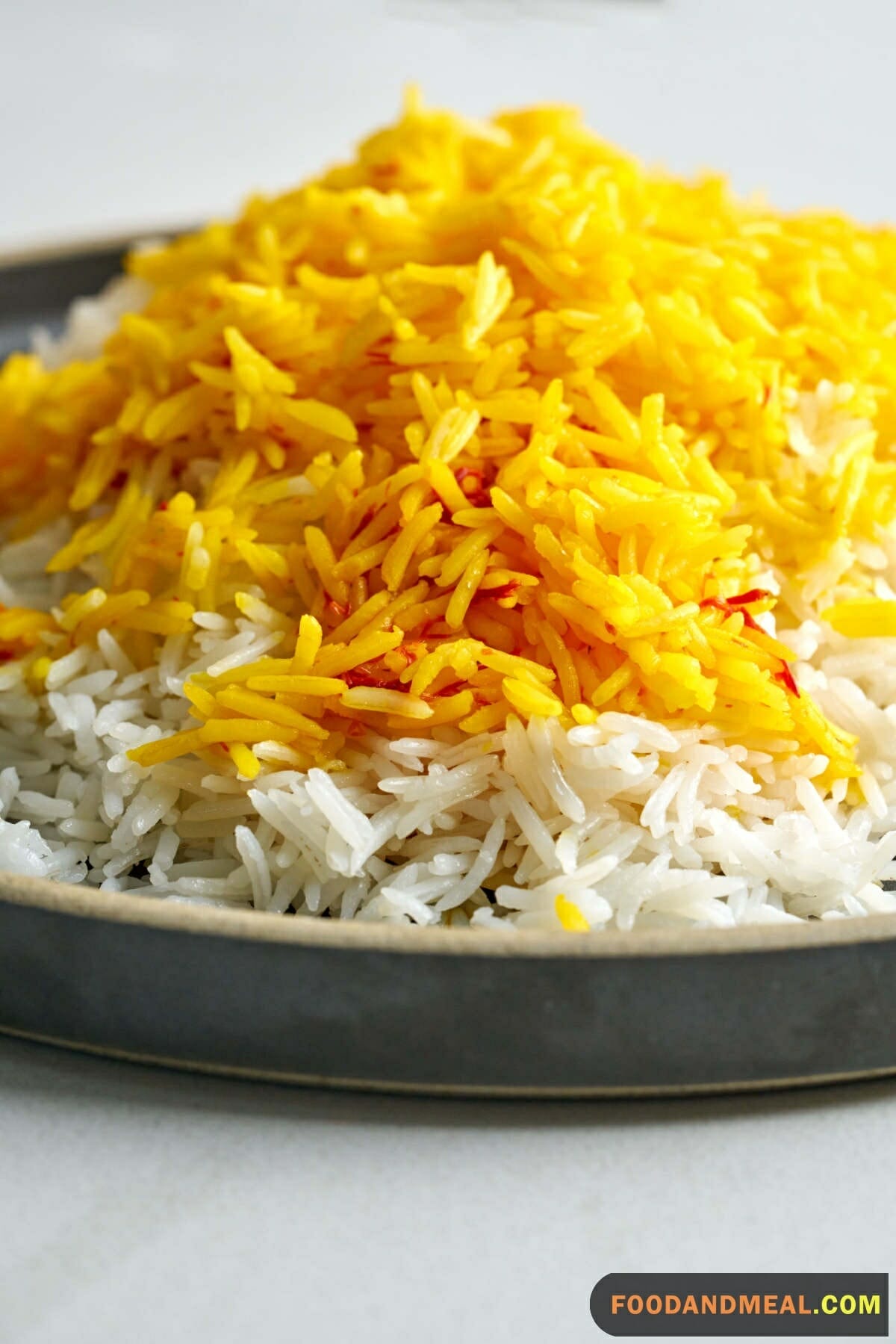
The key is taking the time to really infuse the rice with flavor. I like to sauté the grains in butter or oil first to coat each one and get them glistening. Don’t rush this step! Then layer in aromatics like saffron, cardamom and cinnamon sticks to permeate the rice with their exotic perfume. When I open the pot after cooking, the aromas are absolutely heavenly.
My favorite trick is scraping the bottom of the pot to get crispy bits of rice and let them bake into an ultra-crunchy tahdig crust. I’ll sprinkle on some extra butter or oil right before serving too for added richness. Scooping up those shatteringly crispy morsels contrasted with fluffy saffron rice is my favorite part of every bite!
Serving Suggestions
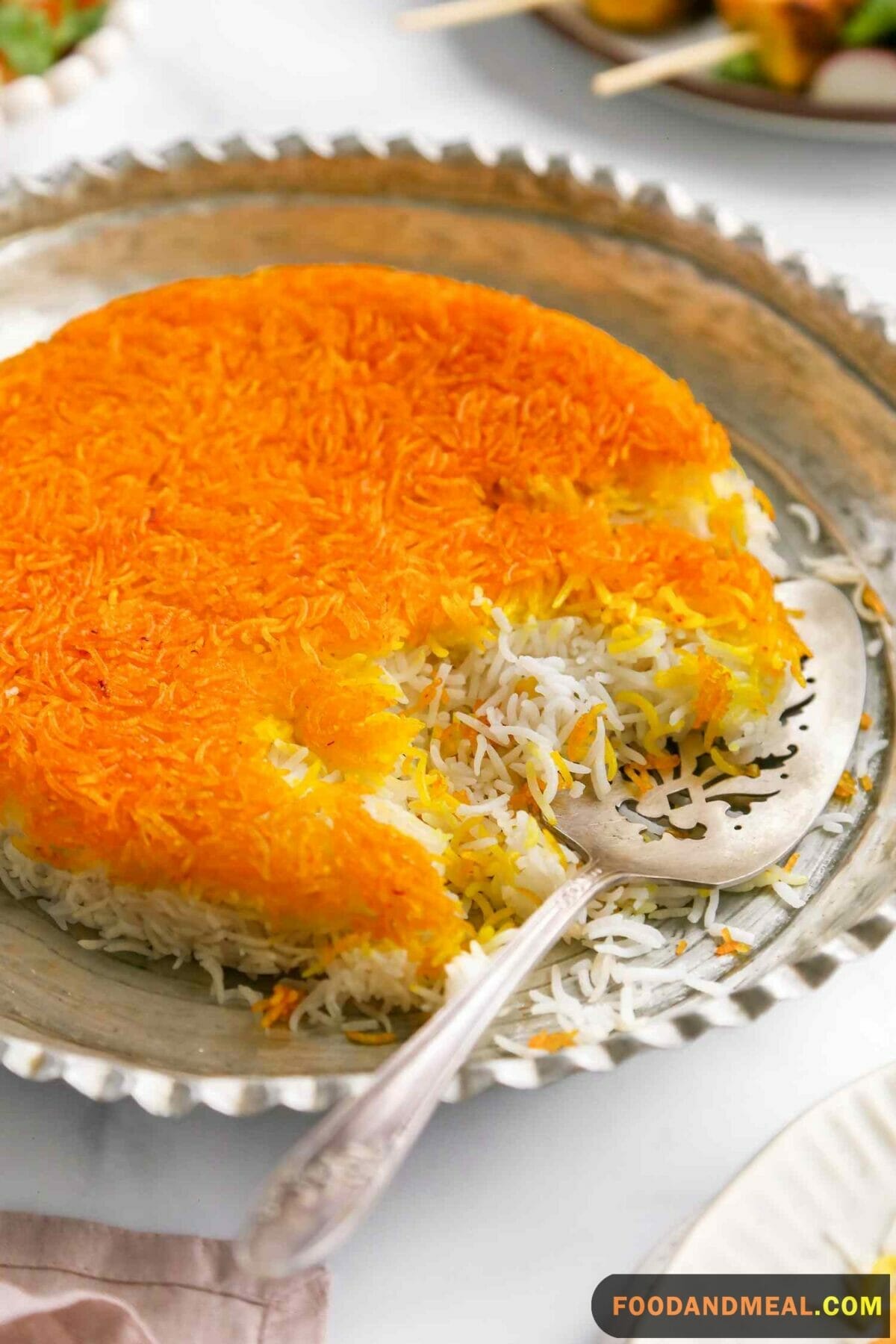
To complement the rich flavors and fragrant aroma of Persian Rice, consider serving it with a side of Spinach Quiche. The creamy texture and savory taste of the quiche will provide a delightful contrast to the aromatic rice, creating a satisfying and balanced meal. Alternatively, you could pair the Persian Rice with a refreshing Kohlrabi Salad, featuring crisp kohlrabi slices tossed with a tangy dressing and fresh herbs. The light and crunchy salad will add brightness to the dish, enhancing its overall appeal. For a heartier option, serve the Persian Rice alongside Masbate Bulalo, a Filipino beef soup known for its rich broth and tender meat. The comforting flavors of the bulalo will complement the aromatic rice, creating a satisfying meal that’s perfect for any occasion. Whichever pairing you choose, the fragrant and flavorful Persian Rice will undoubtedly be the star of the show.
Frequently Asked Questions about Persian Rice
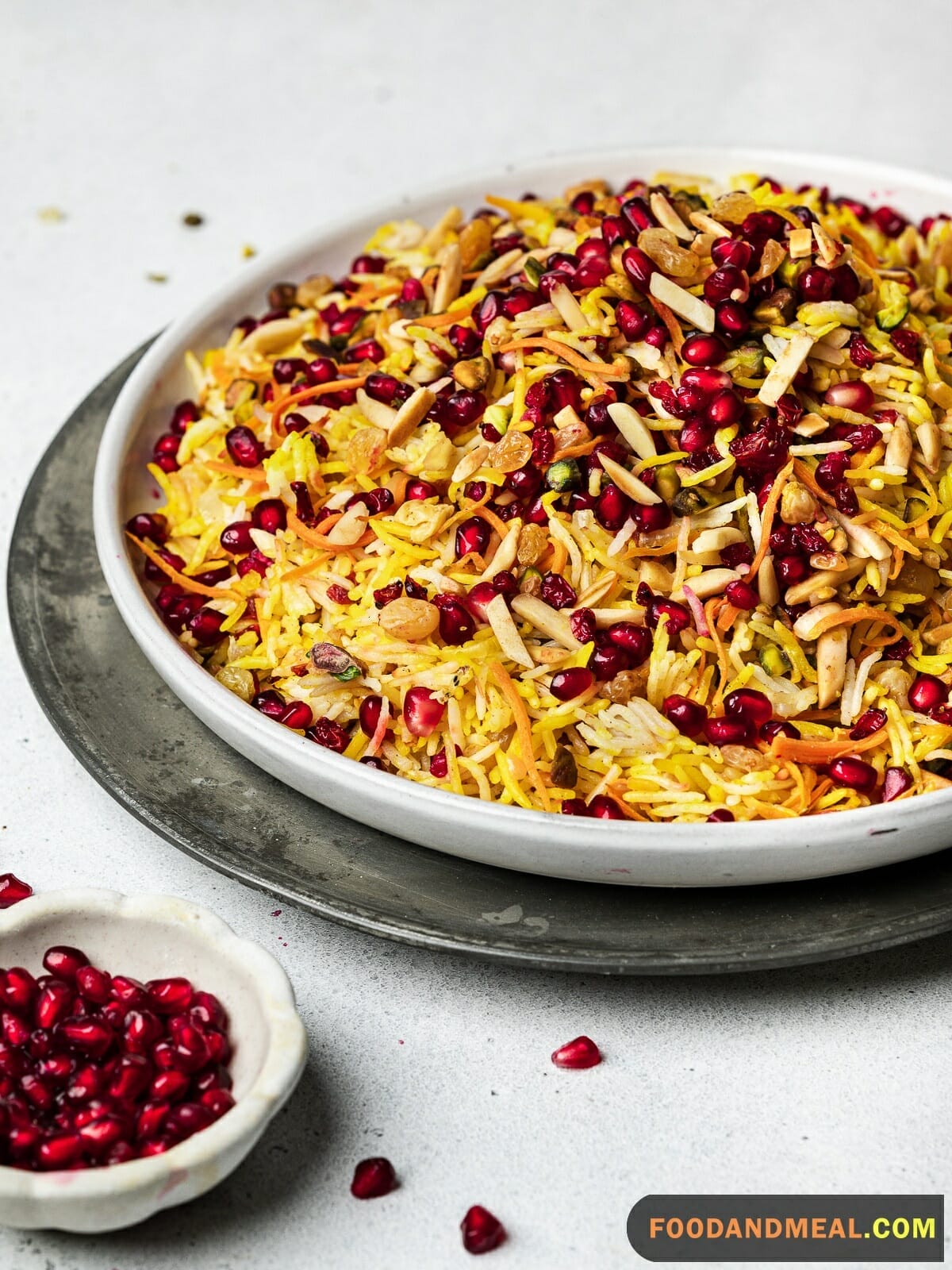
- What is “Tahdig,” and how do I achieve the perfect crispy crust? To make “Tahdig,” the coveted crispy crust of Persian Rice, use a non-stick pot. Add a mixture of oil and saffron-infused water to the bottom before adding the parboiled rice. Cook over low heat, and when serving, gently invert the pot onto a plate to reveal the golden crust.
- Can I use other types of rice for Persian Rice? While Basmati rice is the traditional choice, you can experiment with other long-grain rice varieties. Just ensure they have similar cooking times and soak them before cooking.
- What are some serving suggestions for Persian Rice? Persian Rice pairs wonderfully with kebabs, stews like Ghormeh Sabzi, and grilled vegetables. It’s also delicious with yogurt, fresh herbs, and barberries. Get creative with your toppings!
- Is Persian Rice suitable for vegetarians and vegans? Yes, Persian Rice is vegetarian and vegan-friendly. It’s a versatile base that can accompany a variety of plant-based and meat dishes.
- How can I store leftover Persian Rice? To store leftover Persian Rice, place it in an airtight container and refrigerate. Reheat gently with a splash of water or oil to revive its texture and flavors.
Conclusion
I hope you’ve enjoyed this little foray into the vibrant, flavorful world of Iranian cooking as much as I have. There’s just something so satisfying about transforming a simple side dish into an aromatic feast for the senses.
If you give this Persian Rice a try, I’d love to hear how it turns out! Post a photo on Instagram and tag @foodandmeal so I can see your delicious creations. Did you bake the tahdig or try infusing with different spices? I’m always looking for new ways to put a twist on this beloved staple.
And be sure to keep checking the Food and Meal blog for more international recipe inspiration. Persian cuisine is filled with fragrant rice dishes, herb-infused stews, and brightly colored appetizers that I can’t wait to share. I’ll dish out my best tips for sourcing specialty ingredients like saffron and making exotic dinners approachable any night of the week.
I'm Tracy F Hilton, a devoted culinary professional shaped by a mix of natural aptitude and refined skills from a top culinary school. In the dynamic kitchen environment, I'm a catalyst for seamless operations and timely, high-quality dish preparation. My culinary creations are a blend of art and skill, offering visually and gustatorily delightful experiences. A learner at heart, I'm continuously honing my craft, embracing new techniques, and culinary innovations. My positive, collaborative nature is amplified in fast-paced settings, showcasing my commitment to team efficiency and guest satisfaction. Each dish I present is a meticulous blend of tradition and innovation, promising an unforgettable dining experience that marries taste, aroma, and aesthetic appeal in perfect harmony. Join me on a gastronomic journey where each bite encapsulates a rich, evolving narrative of flavors and culinary artistry.


